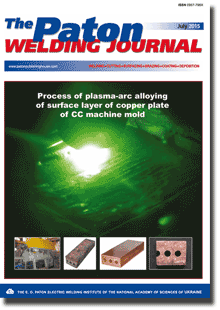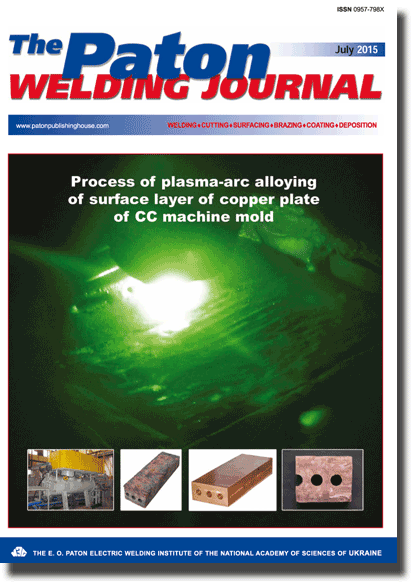| 2015 №07 (02) |
DOI of Article 10.15407/tpwj2015.07.03 |
2015 №07 (04) |

The Paton Welding Journal, 2015, #7, 16-21 pages
Some advantages of butt joints of thin wrought aluminium alloys AMg5M and AMg6M produced by FSW, compared to TIG-welded joints
A.G. Poklyatsky, I.N. Klochkov And S.I. Motrunich
E.O. Paton Electric Welding Institute, NASU. 11 Bozhenko Str., 03680, Kiev, Ukraine. E-mail: office@paton.kiev.ua
Abstract
Comparative studies were performed of microstructure, degree of softening, ultimate strength, crack initiation and propagation susceptibility and fatigue resistance of welded joints of wrought aluminium alloys AMg5M andAMg6M 1.8 mm thick, produced by nonconsumable-electrode argon-arc welding and friction stir welding, as well as of the levels of residual longitudinal stresses developing in them. It is shown that application of FSW enables formation of permanent joint with minimum level of stress concentration in weld-to-base metal transition areas, and allows avoiding defects in the form of pores, oxide film macroinclusions and hot cracks in welds due to metal melting and solidification in fusion welding. Intensive plastic deformation of metal results in formation of a uniform disoriented structure under the tool shoulder and in the weld nugget with grain size of 3-4 mm and disperse (not more than 1 mm) phase precipitates, and grain elongation and distortion in the direction of plasticized metal displacement occur in the adjacent areas. This leads to increase of metal hardness in the joint zone, sample ultimate strength at uniaxial tension, their fatigue strength and lowering of crack initiation and propagation susceptibility. Lowering of temperature of welded edges heating leads to lowering of maximum level of residual longitudinal stresses in welded joints by 25 %, compared to TIG welding. 16 Ref., 8 Figures.
Keywords: friction stir welding, aluminium alloys, hardness, microstructure, ultimate strength, fatigue
Received: 23.03.15
Published: 13.10.15
References
- Beletsky, V.M., Krivov, G.A. (2005) Aluminium alloys (composition, properties, technology, application): Refer. Book. Ed. by I.N. Fridlyander. Kiev: KOMINTEX.
- Rabkin, D.M., Lozovskaya, A.V., Sklabinskaya, I.E. (1992) Metals science of welding of aluminium and its alloys. Kiev: Naukova Dumka.
- Mashin, V.S., Poklyatsky, A.G., Fedorchuk, V.E. (2005) Mechanical properties of aluminium alloys in consumable and nonconsumable electrode arc welding. The Paton Welding J., 9, 39-45.
- Poklyatsky, A.G. (2001) Peculiarities of formation of oxide film macroinclusions in weld metal of aluminium alloys (Review). Ibid., 3, 36-38.
- Klimenko, Yu.V. Method of friction welding of metals. USSR author's cert. 195846. Int. Cl. B23K 35/02. Fill. 09.11.1965. Publ. 04.05.1967.
- Thomas, W.M., Nicholas, E.D., Needham, J.C. et al. Friction stir butt welding. Int. pat. appl. PCT/GB 92/02203; GB pat. appl. 9125978.8. Publ. 1991.
- Shibayanagi, T. (2007) Microstructural aspects in friction stir welding. J. Japan Inst. of Light Metals, 9, 416-423. https://doi.org/10.2464/jilm.57.416
- Pietras, A., Zadroga, L. (2003) Rozwoj metody zdrzewania tarciowego z mieszaniem materialu zgrzeiny (FSW) i mozliwosci jej zastosowania. Biul. Instytutu Spawalnictwa w Gliwicach, 5, 148-154.
- Sato, Y. (2002) Relationship between mechanical properties and microstructure in friction stir welded Al alloys. J. JWS, 8, 33-36. https://doi.org/10.2207/qjjws1943.71.581
- Larsson, H., Karlsson, L., Svensson, L. (2000) Friction stir welding of AA5083 and AA6082 aluminium alloys. Svetsaren, 2, 6-10.
- Kluken, A., Ranes, M. (1995) Aluminium bridge constructions - Welding technology and fatigue properties. Ibid., 3, 13-15.
- Ericsson, M., Sandstrom, R. (2003) Influence of melting speed on the fatigue of friction stir welds, and comparison with MIG and TIG. Int. J. Fatigue, 25, 1379-1387. https://doi.org/10.1016/S0142-1123(03)00059-8
- Lanciotti, A., Vitali, F. (2003) Characterization of friction welded joints in aluminium alloy 6082-T6 plates. Welding Int., 8, 624-630. https://doi.org/10.1533/wint.2003.3148
- Jata, K.V., Sankaran, K.K., Ruschau, J.J. (2000) Friction stir welding effects on microstructure and fatigue of aluminum alloy 7050-T7451. Metallurg. Transact. A, 31, 2181-2192. https://doi.org/10.1007/s11661-000-0136-9
- Ishchenko, A.Ya., Poklyatsky, A.G. Tool for friction stir welding of aluminium alloys. Pat. 54096 Ukraine. Int. Cl. B23K 20/12. Fill. 30.04.2010. Publ. 25.10.2010.
- Poklyatsky, A.G. (2011) Resistance of welds on thin-sheet aluminium alloys to initiation and propagation of service cracks. The Paton Welding J., 10, 5-9.
Suggested Citation
A.G. Poklyatsky, I.N. Klochkov And S.I. Motrunich (2015) Some advantages of butt joints of thin wrought aluminium alloys AMg5M and AMg6M produced by FSW, compared to TIG-welded joints. The Paton Welding J., 07, 16-21.The cost of subscription/purchase order journals or individual articles
| Journal/Currency | Annual Set | 1 issue printed |
1 issue |
one article |
| TPWJ/USD | 384 $ | 32 $ | 26 $ | 13 $ |
| TPWJ/EUR | 348 € | 29 € | 24 € | 12 € |
| TPWJ/UAH | 7200 UAH | 600 UAH | 600 UAH | 280 UAH |
| AS/UAH | 1800 UAH | 300 UAH | 300 UAH | 150 UAH |
| AS/USD | 192 $ | 32 $ | 26 $ | 13 $ |
| AS/EUR | 180 € | 30 € | 25 € | 12 € |
| SEM/UAH | 1200 UAH | 300 UAH | 300 UAH | 150 UAH |
| SEM/USD | 128 $ | 32 $ | 26 $ | 13 $ |
| SEM/EUR | 120 € | 30 € | 25 € | 12 € |
| TDNK/UAH | 1200 UAH | 300 UAH | 300 UAH | 150 UAH |
| TDNK/USD | 128 $ | 32 $ | 26 $ | 13 $ |
| TDNK/EUR | 120 € | 30 € | 25 € | 15 € |
AS = «Automatic Welding» - 6 issues per year;
TPWJ = «PATON WELDING JOURNAL» - 12 issues per year;
SEM = «Electrometallurgy Today» - 4 issues per year;
TDNK = «Technical Diagnostics and Non-Destructive Testing» - 4 issues per year.


